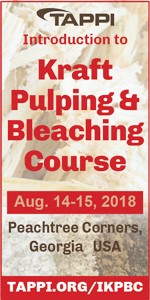| |
 · www.tappi.org
· www.tappi.org
· Subscribe
to Ahead of the Curve
· Newsletters
· Ahead
of the Curve archived issues
· Contact
the Editor

|
|
|
|
Canadian Newsprint Tariffs Taking a Toll
This article also appeared in TAPPI's Over the Wire newsletter on May 14, 2018, and is offered here for Ahead of the Curve readers who may have missed it.
On May 11, the LA Times reported effects of preliminary findings by the US Commerce Department resulting in anti-dumping duties of 22 percent for many Canadian paper companies. Together, the two sets of duties have raised the price of newsprint 30 percent. Two decades ago, there were about 15 newsprint mills in the US. Now there's only a small handful left.
Little-noticed amid the trade war discussion, tariffs levied by the Trump administration on the Canadian paper used to make newsprint are starting to take a toll on US newspapers and printers. In the last few months, the Commerce Department has put in place two sets of duties on producers and exporters of uncoated groundwood paper from Canada. The first, in January, ranged from 4.42 percent to 9.93 percent of the wholesale price after a preliminary determination that suppliers had received financial assistance from the Canadian government.
Then in March, a separate preliminary finding by the Commerce Department resulted in anti-dumping duties of 22.16 percent for some Canadian paper producers and exporters. Together, the two sets of duties have raised the price of newsprint by about 30 percent. Final results for both investigations are expected in August.
Effects are Showing
Some US newspapers and third-party printers say they've already seen the effect of the tariffs in industries that are already facing declining revenues. The Tampa Bay Times said it will eliminate about 50 jobs by June to try to manage the estimated US$3.5-million additional cost the paper will pay per year as a result of the tariffs.
"It's really going to have a devastating effect on the newspaper industry, and it will ripple through the rest of the printing industry," said Frank Romano, professor emeritus at Rochester Institute of Technology and an expert in printing. "You're almost taxing some newspapers out of business."
The petitions that led to the tariffs were filed in August by North Pacific Paper Co., a Longview, WA, producer of uncoated groundwood paper — the material on which most newspapers are printed.
Two decades ago, there were about 15 newsprint mills in the US, said Paul Boyle, senior vice president of public policy at the News Media Alliance, a trade group representing almost 2,000 news organizations. But as the newspaper industry fell on difficult times and demand for newsprint steadily decreased, the mills began to disappear.
Today, there are only a handful left in the nation, Boyle said.
The US demand for newsprint is 2.4 million tons, he said; Canadian paper mills provide about 60 percent of that. At the Tampa Bay Times, about 80 percent of its newsprint supply was Canadian, said Paul Tash, chairman and chief executive of the Tampa Bay Times/Times Publishing Co.
"America does not produce enough newsprint to meet the needs of American customers," he said. "There's not a lot of spare capacity in the market."
Tronc Inc., parent company of the Los Angeles Times (as well as the Chicago Tribune and several other national city newspapers) declined to comment on how the tariffs would affect the paper. But during an earnings call Wednesday, Tronc Chief Financial Officer Terry Jimenez said newsprint was at "historically extraordinarily high prices," mostly due to the tariffs.
"A government-supported policy that makes the production of newspapers costlier at an inflection point in the industry is unwise and unwarranted," Tronc Chairman and Chief Executive Justin Dearborn said on the call. "We strongly oppose the tariffs and believe they are counterproductive to public policy and to free markets broadly."
'Leveling the Playing Field'
North Pacific Paper, which is owned by private equity firm One Rock Capital Partners, said it understands the concerns voiced by newspaper publishers. But company spokesman David Richey said the firm strongly disagreed "with the notion that their industry requires low-priced, subsidized newsprint from Canada to sustain their own business model."
The company closed one of its three paper machines last fall, a move a company spokesman attributed to the prior trade environment. "We are not asking for anything but a level playing field with the Canadian producers," Richey said.
Boyle of the News Media Alliance said the new tariffs would be unlikely to spur a paper mill rebirth. His organization is part of a coalition of dozens of newspaper publisher groups, printers and paper producers that are protesting the tariffs and plan to make their case to the US International Trade Commission this summer.
"I think it's foolish to believe someone's going to start a newsprint mill and spend US$200 million to US$300 million to build a mill ... when you see a decline in newsprint," Boyle said.
Other representatives of printing companies that produce items such as magazines, catalogs, and retail advertising inserts say they're also preparing for a major financial hit. Canadian newsprint makes up about 20 percent of the volume moving through the presses at printer Quad/Graphics, a Sussex, WI, company that has 20,000 employees in 25 states, including about 750 in California.
Quad buys about 300,000 tons of Canadian uncoated groundwood paper each year and expects to see an annual cost increase of about US$15 million, said Pat Henderson, director of government affairs. This comes as Quad's top-line revenues have been falling about 5 percent each year. The company has made 15 acquisitions since 2010, but print volume is still on the decline, Henderson said.
For a modest investment of $174, receive more than US$ 1000 in benefits in return.
Visit www.tappi.org/join for more details. |
|



